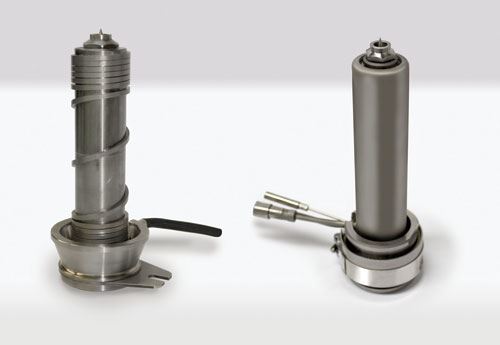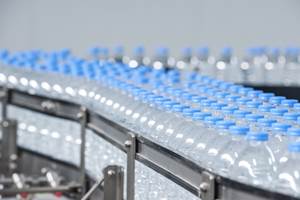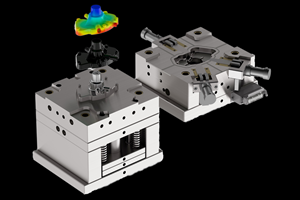Standardizing Short- and Long-Run Production
New hot sprue bushing technology makes it possible to replicate the full hot runner system for low-volume production.
Short-run and prototype molding are specialized areas of mold manufacturing with intricacies that have long posed challenges for anyone dealing with both short- and long-run applications. Different components for these various applications have required molders to maintain costly inventory and spend valuable time on changeovers while struggling to keep quality consistent between short and long runs.
However, recent advancements are making it possible to standardize mold components for the full range of production volumes and jobs. Here we will take a look at a new type of hot sprue bushing technology that is ideal for short-run and prototype molding, but is also tough enough for longer runs.
Often, a short run or a prototype warrants a single-cavity mold, which lends itself to a single-drop hot sprue bushing to eliminate the waste and added cycle time produced by cold sprues. However, until now because of the limited durability of traditional hot sprue bushings, you had to use a different one from job to job. Plus, the difference in tip designs between the hot sprue bushing and a multi-drop hot runner system created problems in terms of complexity and consistency.
New standardized single-drop hot sprue bushing technology can enable moldmakers to simulate the multi-drop systems of high-volume jobs. Using the same flow channel and heat source as a multi-drop system, the new hot sprue bushing can simplify mold design, inventory and part consistency. No longer do short-run molders need special heaters, tips, retainers and needles for production.
Durability
Single-drop systems have a reputation for being less durable than multi-drop systems, but this bushing technology has been found to withstand millions of cycles matching the quality found in multi-drop hot runner systems. The key is its heater design, which incorporates a standard slip-on, cast-in heater in the nozzle body. The heater is embedded in brass, which conducts heat more evenly, and enclosed in the nozzle body.
The enclosure protects the heater from the tendency to break its seal as it loosens from the body as a result of heating and contracting in open air. The enclosed sprue lasts 50 percent longer.
This improved durability allows molders to spread the cost of a dedicated hot sprue bushing out over multiple parts, making the benefits of hot runner technology affordable in applications that wouldn’t otherwise justify the cost.
Heat, Readings and Versatility
The cast-in heater provides a more uniform heat profile than traditional square coil heaters. It produces temperatures 50 to 75 degrees flatter, with no hot or cold spots where a coil heater may or may not be touching the nozzle body.
In traditional hot sprue bushings, the thermocouple is located in the nozzle body heater. You can see when the heater is at the desired temperature, but then you must wait to allow the steel to heat up to that temperature—not getting an accurate reading of the temperature in the steel of the nozzle.
This new bushing technology has two zones of heat: (1) the slip-on, cast-in heater on the nozzle body and (2) a square coil heater with a separate thermocouple on the head of the nozzle. The new technology embeds the thermocouple in the steel to give a true temperature reading of the nozzle itself. With accurate temperature readings, heat soak time is eliminated, reducing cycle times.
Another important aspect of this design is that you can control the heaters separately or run them together as one zone. Two different areas of the machine’s heat converge where the nozzle feeds. The nozzle body off the main machine is cooler than the tip. With only a single zone, the hot sprue would overheat the tip because it would be accounting for the full area of nozzle body as well. With a two-zone system, you can maintain the desired temperature in the tip even as the nozzle body temperature fluctuates.
As a result, the sprue can handle a wide range of materials, including a broad range of crystalline polymers. The greater temperature control is also a weapon against stringing, which can otherwise deter molders and moldmakers from using more efficient hot sprues even though they have shorter cycle times and waste less material than cold sprues.
One final feature is the length from the nozzle to the mold plate matching standard steel sizes, with which single-drop components are more versatile and can be used on multi-drop systems as well—helping molders avoid having to stock specialized components for short-run setup.
Prototyping Applications
When prototyping, it is important for moldmakers to use the same nozzle and heater that would be used later in a multi-drop system. The reason is that materials react differently if the technologies that produce them don’t match.
This new single-drop hot sprue bushing nozzle fits the same tips and uses the same heaters as a multi-drop system. Not only will the outputs be accurate at both phases of production, but the exact nozzle can even be changed over—enabling the materials to react the same throughout the production of the part.
Given the versatility for prototyping, short runs and even higher-volume production, along with its standardized sizes, this ingle-drop hot sprue bushing technology can now be incorporated into more molds easily, interchangeably and cost effectively.
Related Content
Mold Innovations Power Unique Auto Lighting Elements on Hummer EVs
Diamond machining, electroforming of micro-optical inserts and modified latch-lock system help injection molds produce unique forward lighting elements.
Read MoreWhat is Driving Mold Lifecycle Management Digitalization?
OEMs are looking to partner with suppliers to share and track data across the supply chain for advanced intervention and process management.
Read MoreFundamentals of Designing the Optimal Cooling System
The right mold components can help improve mold cooling and thereby produce higher-quality parts.
Read MoreTips for Tackling Mold Design, Machining, Cutting Tool and Wear Challenges
Tips for tasks ranging from reducing risk in part design and taking advantage of five-axis machining to refining cutting tool performance and reducing wear with guiding and centering systems.
Read MoreRead Next
Are You a Moldmaker Considering 3D Printing? Consider the 3D Printing Workshop at NPE2024
Presentations will cover 3D printing for mold tooling, material innovation, product development, bridge production and full-scale, high-volume additive manufacturing.
Read MoreReasons to Use Fiber Lasers for Mold Cleaning
Fiber lasers offer a simplicity, speed, control and portability, minimizing mold cleaning risks.
Read MoreHow to Use Continuing Education to Remain Competitive in Moldmaking
Continued training helps moldmakers make tooling decisions and properly use the latest cutting tool to efficiently machine high-quality molds.
Read More








.png;maxWidth=300;quality=90)


















